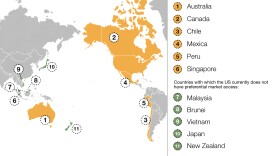By Happy Chambers
http://stream.publicbroadcasting.net/production/mp3/wkms/local-wkms-956478.mp3
Murray, KY – The Kentucky Department of Fish and Wildlife Resources has proposed a "first ever" hunting season on sandhill cranes to begin during the 2011/2012 hunting season. Hap Chambers is a volunteer with the US Fish and Wildlife Service at Clarks River National Wildlife Refuge Environmental Education Program with more about the crane hunt.
I am here to speak to you about sandhill cranes
We have 2 species of crane in North America, the Sandhill Crane and the endangered Whooping Crane. The sandhill is a Gray birds with white cheeks and red on the top of their heads. Plumage often stained with rusty pigment from soil. The sandhill cranes that we see in Kentucky stand about 5 feet tall with a wing span of 6-7 feet Call. Gurgling groo call is one of the most memorable sounds in nature. Dancing. All ages engage in elaborate "dances" of jumps, raised wings, bowing, grass throwing, etc.
Sandhill cranes tend to travel in flocks, so if you find one, you're likely to find a few dozen. Although sandhill cranes typically roost in or near water at night, during the day they are more like to be found in flocks in harvested cornfields. Sandhill cranes were hunted almost to extinction in the early 1900's, but they've come back slowly, and most populations now seem to be doing well. They have a very low reproduction rate, with a nesting pair averaging only one surviving chick every three years. This low reproduction rate is part of the reason it took them so long to recover.
Sandhill cranes mate for life and can live for decades. They do not currently nest in Kentucky. Until 15 or so years ago, sandhill cranes migrated through Kentucky, but didn't stop in the state for any extended time. Now they winter at two spots in the state. A large group of cranes stays around Barren River Lake, east of Bowling Green. A smaller group winters near Cecilia, just west of Elizabethtown.
PROPOSED HUNTING SEASON
For more than 90 years, sandhill cranes have migrated through Kentucky without being hunted. The Kentucky Department of Fish and Wildlife Resources has proposed a "first ever" hunting season on sandhill cranes to begin during the 2011/2012 hunting season. If the proposal is approved, KDFWR will sell 400 permits to allow for a harvest of 2 cranes for permit.
Points against the proposed sandhill crane season. There is no need for this season. KDFWR makes frequent reference to the science behind the proposed season, but all the science has claimed is that the eastern population of sandhill cranes can sustain a hunting season without dropping back to a threatened status. No science has supported the need to start a hunting season on sandhill cranes. We do not know if this population will sustain itself without hunting. The number of cranes we now have in KY is a recent phenomenon which has occurred only in the past 3-5 years. The peak numbers have been reached only in the past 13 months.
There could be a natural plunge in their numbers for reasons yet unknown. "Crop depredation" may be raised as a potential justification for starting a hunting season, since cranes will sometimes eat seedlings and shoots. Timing of sandhill cranes in Kentucky means that crop damage by cranes is not likely to be an issue in Kentucky, and problematic crop depredation has not been demonstrated in the state We could find no evidence that starting a hunting season would affect the level of crop damage in other states. Nonlethal methods of protecting crops now seem to be available.
No one is proposing a hunting season on whooping cranes, but a sandhill crane hunting season might increase the chances of an accidental shooting. Sandhill cranes are an inspiring species that represent a chance to help an increasingly urbanized world connect with the outdoors. We are missing an opportunity to broaden the base of support for the wildlife habitat. (The economic impact of hunting is dwarfed by the economic impact of "nonconsumptive" outdoor activities.) I am here representing the Kentucky Coalition for Sandhill Cranes. We are not an organization that opposes hunting. The Kentucky Coalition for Sandhill Cranes is working to maintain the current level of protection for Kentucky's sandhill cranes. The Coalition feels that Kentuckians who oppose the new hunting season should have a real voice in the process - a chance to be heard while it can still make a difference and a chance to influence the outcome.
One major step in the process of approval is the May 2011 Commissioners meeting. Some public comment may be accepted at that meeting. The best chance to be heard is to write or call the KDFWR before May.
We welcome members and encourage you to visit the following web site: kyc4sandhillcranes.wordpress.com
Letters may be written to the KDFWR Commissioners office if you would like to voice your opinion.
Hap Chambers is a volunteer with the US Fish and Wildlife Service at Clarks River National Wildlife Refuge Environmental Education Program.





